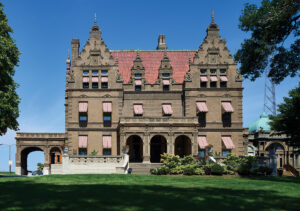Lovers of American history will strike gold in Alaska. Here are five must-see stops along the path less traveled in the Last Frontier State.
Wrangell-St. Elias National Park & Preserve
At 13 million acres, Wrangell-St. Elias is the largest national park in the United States. Within its borders are nine of the 16 tallest peaks in North America and the northernmost active volcano on the continent, Mount Wrangell.
The Kennecott copper mines on the southern flank of the Wrangells produced more than 1 billion pounds of ore between 1911 and 1938, and most of the historic structures have been preserved. Nearby are the small gold mining communities of Dan Creek and May Creek (now abandoned), which date back to the days of the Klondike Gold Rush. On the Wrangells’ north flank are the gold rush ghost towns of Chisana and Bonanza, still mostly intact. Placer mining is allowed here. Several local air services fly hikers and prospectors into the region.
The Nabesna Road enters the park from the town of Slana to the north. Slana is the site of the last federal homestead lands, which opened to settlement in the 1980s. Just south of Slana are the remains of the Russian outpost Batzulnetas, whose occupants were massacred by natives in 1856. The road ends at the historic Nabesna Mine. Now privately owned, the mine dates from 1923.
www.nps.gov/wrst • (907) 822-5234
The Cathedral of St. Michael the Archangel, Sitka
Founded in 1799 by Alexander Baranof of the Russian American Company, Sitka was the “Jewel of the Pacific” long before San Francisco or Seattle grew to prominence. Russia secured its claim to Alaska through the presence of the Russian Orthodox Church. Saint Michael the Archangel Cathedral, built in 1844, was once the seat of the Russian Orthodox Diocese governing all North America. Destroyed by fire in 1966, the cathedral was painstakingly rebuilt. Many of the original icons and furnishings were saved from the inferno by Sitka residents. Among the surviving pieces is Our Lady of Sitka, also known as the Sitka Madonna.
Tours of the cathedral, where services are still held, are given by Russian Orthodox priests.
www.sitka.org • (907) 747-8120
Independence Mine State Park, Hatcher Pass
Situated above the tree line among the peaks of the Talkeetna Mountains, this 271-acre park is located on the site of the Alaska Pacific Consolidated Mining Company’s operations in the 1930s and ’40s. The company’s Independence Mine produced 34,000 ounces of gold between 1938 and 1942.
The mine manager’s home has been converted into a visitor center, and the assay office is now a museum. A mess hall, bunkhouses, equipment shops and several other original buildings still stand. Hiking trails radiate in all directions, including one that follows an old mule trace up Skyscraper Mountain to the remains of the 1906 Martin Mine.
www.dnr.state.ak.us/parks/units/ indmine.htm • (907) 745-2827
Whitney Museum, Valdez
There’s more to Valdez than an oil spill. The largest private collection of native Alaskan art in the United States can be found at the Maxine and Jesse Whitney Museum on the south side of the Valdez Airport Terminal. The Whitneys spent more than 50 years buying pieces from native artists, including clothing, ivory carvings, masks and dolls. Prince William Sound Community College acquired the collection in 1998; a new facility is expected to open by the summer of 2008.
www.pwscc.edu/museum.shtml • (907) 834-1614
University of Alaska Museum of the North, Fairbanks
The world of the Alaskan interior is brilliantly displayed at the University of Alaska’s Museum of the North located on the Fairbanks campus. Centered around Blue Babe, a mummified 26,000- year-old steppe bison, the Gallery of Alaska features discoveries from prehistoric Alaska that were preserved in the permafrost, mineralogy ranging from gold to gem-quality diamonds, native culture, Alaskan art, geology, wildlife and natural phenomena. A special exhibit, “Forced to Leave,” examines the detention of Japanese Americans and Aleuts during World War II.
www.uaf.edu/museum • (907) 474-7505
Originally published in the June 2007 issue of American History. To subscribe, click here.




